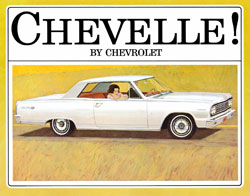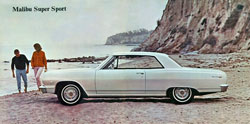1964-1977 Chevelle
As one of the industry’s largest A-body and G-body restoration suppliers, Original Parts Group offers thousands of 1964-77 Chevelle parts and accessories, with new parts added daily. Our extensive catalog offers nearly everything from sheet metal, chrome and upholstery to engine parts and the hard-to-find details to finish a restoration with show-winning attention to detail. Shop online or order your OPGI Chevelle parts catalog today.
 Not every Chevelle rolled off the line as a big-block-powered SS, but it would be easy to assume each wore twin sport stripes on its hood and deck lid. Chevy’s popular and powerful intermediate has become synonymous with the muscle car era, representing American horsepower with a pair of Positraction-induced stripes laid all the way down Main Street.
Not every Chevelle rolled off the line as a big-block-powered SS, but it would be easy to assume each wore twin sport stripes on its hood and deck lid. Chevy’s popular and powerful intermediate has become synonymous with the muscle car era, representing American horsepower with a pair of Positraction-induced stripes laid all the way down Main Street.
There were three generations of the Chevelle and all were based on GM’s landmark A-body platform, which used a strong perimeter frame and coil-spring suspension, when many other midsize cars of the era were transitioning to unitized structures. That ultimately made the Chevelle easier to work on and, decades later, easier to restore.
 The first-gen (1964-67) cars rode on a 115-inch wheelbase, but the second-generation shifted to a shorter 112-inch wheelbase for coupes and convertibles, and a slightly longer 116-inch wheelbase for sedans and wagons. The 1973 introduction of the third-generation Chevelle brought a new A-body frame that retained the 112-/116-inch wheelbases, but to accommodate new crash standards, the bodies grew about 5 inches in length. They also got about an inch wider.
The first-gen (1964-67) cars rode on a 115-inch wheelbase, but the second-generation shifted to a shorter 112-inch wheelbase for coupes and convertibles, and a slightly longer 116-inch wheelbase for sedans and wagons. The 1973 introduction of the third-generation Chevelle brought a new A-body frame that retained the 112-/116-inch wheelbases, but to accommodate new crash standards, the bodies grew about 5 inches in length. They also got about an inch wider.
The basic Chevelle platform continued as the foundation for a variety of models, including Malibu, SS and the all-new Laguna, which supplanted the Malibu at the top of the range in 1973. It was distinguished by body-color urethane bumper covers that lent a European aesthetic. A Laguna S-3 was offered starting in 1974, picking up some SS cues, while with an aero-enhancing sloping nose was added in 1975 and ’76 to make the Chevelle sleeker on NASCAR tracks. Cale Yarborough won 34 races in an S-3-bodied race car, as well as two of three consecutive Winston Cup titles.
It was distinguished by body-color urethane bumper covers that lent a European aesthetic. A Laguna S-3 was offered starting in 1974, picking up some SS cues, while with an aero-enhancing sloping nose was added in 1975 and ’76 to make the Chevelle sleeker on NASCAR tracks. Cale Yarborough won 34 races in an S-3-bodied race car, as well as two of three consecutive Winston Cup titles.
Chevrolet discontinued the Chevelle after 1977, when the next-generation A-body was downsized for 1978 and would carry on only as the Malibu.
Performance legacy
 Because the Chevelle represented the entry point for Chevy’s intermediate-sized lineup, its range of models and trim lines was almost endless – as was its roster of engine choices. The SS (officially Malibu SS at first) was, of course, the performance leader, but it took the success of corporate cousin Pontiac GTO to really get the Chevelle’s horsepower momentum moving, with now-legendary packages including the 350-hp L-79 327 and 396 big-block-powered Z-16 models of 1965.
Because the Chevelle represented the entry point for Chevy’s intermediate-sized lineup, its range of models and trim lines was almost endless – as was its roster of engine choices. The SS (officially Malibu SS at first) was, of course, the performance leader, but it took the success of corporate cousin Pontiac GTO to really get the Chevelle’s horsepower momentum moving, with now-legendary packages including the 350-hp L-79 327 and 396 big-block-powered Z-16 models of 1965.
 Chevelle performance – and the muscle car era itself – reached its zenith in 1970 with the SS’s optional LS-6 454 engine rated at 450 hp. It was capable of mid-13-second quarter-mile blast on its skinny, factory-issued bias-ply tires. Horsepower eroded quickly in the following years, with falling compression ratios and rising fuel economy/emissions standards effectively choking off Detroit’s traditional V-8 engines.
Chevelle performance – and the muscle car era itself – reached its zenith in 1970 with the SS’s optional LS-6 454 engine rated at 450 hp. It was capable of mid-13-second quarter-mile blast on its skinny, factory-issued bias-ply tires. Horsepower eroded quickly in the following years, with falling compression ratios and rising fuel economy/emissions standards effectively choking off Detroit’s traditional V-8 engines.
In its third generation, the Chevelle’s wide model range continued offer healthy small-block options and even the big-block through 1975. Customers could even order an SS wagon in 1973, which would be the final year for the Chevelle SS.
American classic
 Considering it led a relatively short production life – including less than a decade as a premier muscle car – the Chevelle’s legacy is all the more impressive. It is the quintessential American muscle car, whether it was born with a big-block or straight-six. And with more than a couple million built in all forms – and thousands still on the road to inspire enthusiasts of every generations – the Chevelle will always be an American classic.
Considering it led a relatively short production life – including less than a decade as a premier muscle car – the Chevelle’s legacy is all the more impressive. It is the quintessential American muscle car, whether it was born with a big-block or straight-six. And with more than a couple million built in all forms – and thousands still on the road to inspire enthusiasts of every generations – the Chevelle will always be an American classic.